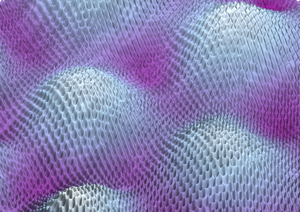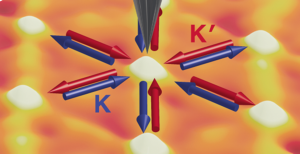 If two lattices, that are slightly twisted with respect to each other, are placed on-top of each other a new superstructure is found, which is referred to as a moiré structure (see figure). For small twist angles a bilayer of graphene exhibits, owing to the crossing of the Dirac cones, novel electronic states in the vicinity of the Fermi level. These novel electronic states, which have an appreciable density of states, can be brought arbitrarily close to the Fermi level leading to electronic instabilities and correlated electron phases, such as superconductivity, Mott metal-insulator transition and/or Wigner crystallization and tunable magnetism.
If two lattices, that are slightly twisted with respect to each other, are placed on-top of each other a new superstructure is found, which is referred to as a moiré structure (see figure). For small twist angles a bilayer of graphene exhibits, owing to the crossing of the Dirac cones, novel electronic states in the vicinity of the Fermi level. These novel electronic states, which have an appreciable density of states, can be brought arbitrarily close to the Fermi level leading to electronic instabilities and correlated electron phases, such as superconductivity, Mott metal-insulator transition and/or Wigner crystallization and tunable magnetism.
moiré materials: new materials with a twist
The twist angle degree of freedom allows to engineer a large class of 2D materials when stacked together to form so-called van der Waals heterostructures, which exhibit only a weak interlayer interaction. Here we study, besides twisted graphene, also other twisted (Mx/My) 2D van der Waals materials (where Mx,y = graphene, silicene, germanene, stanene, h-boron nitride, transition metal dichalcogenides and monochalcogenides). By varying the twist angle between two stacked layers of these materials the periodicity of the superstructure, i.e. the moiré structure, and the electronic properties, such as for instance the location of the Van Hove singularities and/or the location of the Dirac points, can be accurately varied. The availability of such materials provides not only an ideal model system to systematically study and tune the formation of electronic instabilities, but it also provides a wealth of input to advance modern theories of complex quantum phases of matter. The urgency of research is high as the exploration of this realm has barely begun, its promises have not yet been materialized, and the extent of its potential for new physics and devices remains largely untapped.
 For a twist angle of about 0.6o we found compelling evidence for the occurrence of one-dimensional topologically protected electronic transport (see figure). The twisted bilayer graphene exhibits AB as well as BA stacked configurations. The application of an external electric field breaks the inversion symmetry of these two stacking configurations. At each AB/BA domain boundary there are two counter-propagating topologically protected helical channels per valley, resulting in a conductance of 4e2/h. Theory predicts that these topologically protected channels are valley protected. Recently we have shown that the electronic transport in these 1D states is valley-protected, i.e. scattering from valley to valley within the channels and knots is forbidden for topological reasons.
For a twist angle of about 0.6o we found compelling evidence for the occurrence of one-dimensional topologically protected electronic transport (see figure). The twisted bilayer graphene exhibits AB as well as BA stacked configurations. The application of an external electric field breaks the inversion symmetry of these two stacking configurations. At each AB/BA domain boundary there are two counter-propagating topologically protected helical channels per valley, resulting in a conductance of 4e2/h. Theory predicts that these topologically protected channels are valley protected. Recently we have shown that the electronic transport in these 1D states is valley-protected, i.e. scattering from valley to valley within the channels and knots is forbidden for topological reasons.
